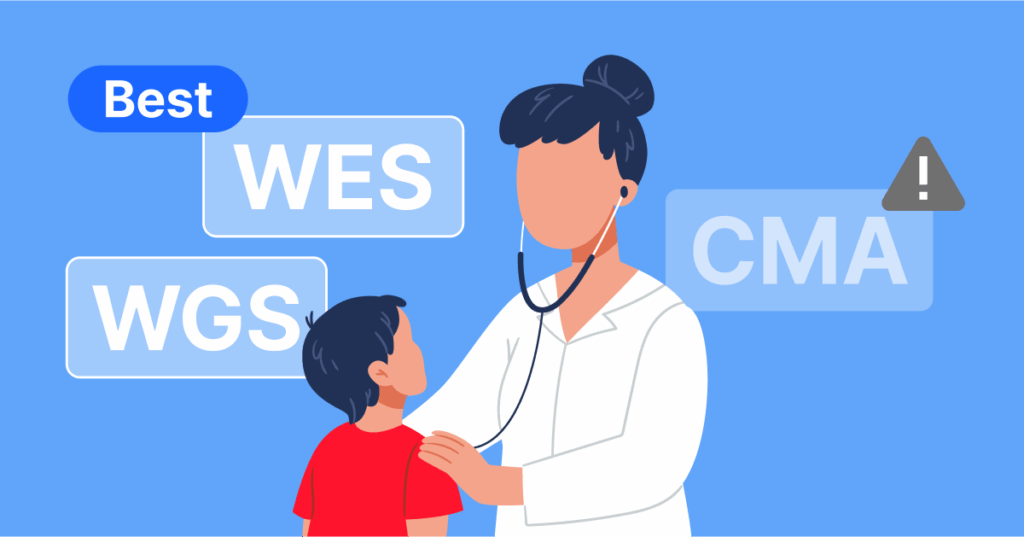🧬 Should CMA still come first in developmental delay?
- Insights | 25. 06. 24
Why whole exome or genome sequencing(WES/WGS) is increasingly considered as a first-tier diagnostic tool

What should we consider first when evaluating children with GDD/ID?
When evaluating children with global developmental delay (GDD) or intellectual disability (ID), many clinicians are accustomed to starting with chromosomal microarray (CMA), especially in the absence of syndromic features.
However, the American Academy of Pediatrics (AAP) released its 2025 clinical report, recommending a shift in the initial diagnostic approach—whole exome sequencing (WES) or whole genome sequencing (WGS) should now be considered as first-tier testing in many cases.
Read more about the report HERE.
“No syndromic features? Start with CMA?” — Is that still valid?
While CMA has long been a standard initial test, especially for detecting structural chromosomal abnormalities, WES and WGS now offer broader diagnostic capabilities.
According to the AAP’s clinical guidance, WES or WGS can be used as a hypothesis-free approach in children without a specific clinical diagnosis, as they can detect a wide range of pathogenic variants—including SNVs, INDELs, CNVs, and more.
Comparing strategies: CMA vs. WES/WGS
For many years, chromosomal microarray (CMA) has served as a widely used first-line genetic test for children with global developmental delay (GDD) or intellectual disability (ID).
Its strength lies in its ability to detect copy number variants (CNVs), with a relatively simple analytical process and a low likelihood of incidental findings.
However, according to the 2025 clinical report from the American Academy of Pediatrics (AAP), whole exome sequencing (WES) and whole genome sequencing (WGS) may offer broader diagnostic benefits when no specific syndrome or diagnosis is suspected.
WES and WGS enable the detection of a wider range of pathogenic variants—including single nucleotide variants (SNVs), small insertions and deletions (INDELs), and even CNVs—many of which are missed by CMA alone.
Additionally, these sequencing-based methods support reanalysis over time, making them more adaptable to evolving clinical phenotypes or newly discovered gene-disease associations.
Of course, WES and WGS also introduce additional considerations, such as the potential for incidental findings and increased interpretive complexity.
These concerns can be mitigated through pre-test counseling, consent processes, and careful alignment with the clinician’s diagnostic goals.
According to the AAP, in the absence of syndromic features, WES or WGS may be more appropriate as first-tier tests given their higher diagnostic yield and greater clinical flexibility.
When a well-defined syndrome is suspected, CMA or targeted testing may still be preferred. Ultimately, the choice should be guided by the individual patient’s clinical presentation and the diagnostic question at hand.

The diagnostic paradigm is evolving
The AAP emphasizes that test selection should be guided by clinical features, but also notes that in cases without a clear syndrome or diagnosis, WES/WGS offers greater yield and flexibility.
This does not render CMA obsolete, but rather suggests that its position in the testing hierarchy may shift depending on patient presentation.
In particular, for patients with multiple non-specific findings or unexplained developmental delay, a sequencing-first approach may be more efficient—clinically and economically.
How 3billion supports clinical genetic diagnostics
At 3billion, our diagnostic services are designed to align with current guidelines and clinical needs. We offer:
- Clinician-friendly reports with phenotype-driven gene filtering
- Simultaneous analysis of SNVs, INDELs, CNVs, and structural variants
- ACMG-based variant interpretation and reanalysis options
- Optional reporting of incidental findings
- Transparent turnaround and reanalysis policies
Wondering if a suspected condition can be diagnosed via WES/WGS?
Use our Gene Coverage Browser to check coverage for specific genes of interest.
Do you find this post helpful?
Click the button below to copy and share the link.

3billion Inc.
3billion is dedicated to creating a world where patients with rare diseases are not neglected in diagnosis and treatment.



